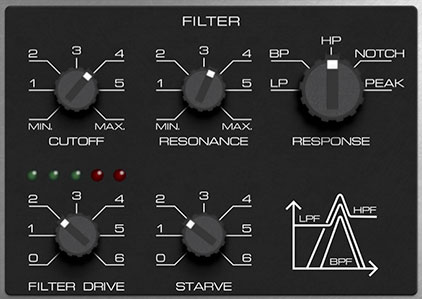The original Polivoks filter is unquestionably its most unique feature - it boasts a truly unique, gnarly distorted tone. Although this certainly wasn't the intended outcome, the Polivoks filter is loved by many synthesists. Over the years, there have been numerous copies of its circuit in the hardware modular synthesis world, but up until now, it hasn't been emulated in the virtual synthesizer world.
The basic design was intended to emulate the 12dB/oct slope state-variable filters seen in Oberheim synths of the 70s and 80s. These are great-sounding filters and highly flexible as a result of their multiple modes (more on this later). Filters of this type made use of a still-relatively-new component called an "operational transconductance amplifier" or OTA. We'll assume that a lack of availability of fancy-pants OTAs in the Soviet Union during the 80s is what drove designer Vladimir Kuzmin to forego the OTA and instead make use of something called a "programmable op-amp" in its place. These were never intended for a variable filter application, but alas, Vladimir Kuzmin figured out a way to use it in such a manner, and thus, the raunchy Polivoks filter was born.
The Original Polivoks Filter vs. Filtomika's Super-Duper New and Improved Filter
The controls for the original Polivoks filter are straightforward and similar to what you'd see in any garden-variety analog synth (cutoff frequency, resonance, envelope controls and depth, etc.). It does however have switchable lowpass and bandpass modes. However, Cherry Audio's Filtomika goes WAY beyond, including the aforementioned lowpass and bandpass modes, plus highpass, notch, and peak modes. (see the Response control section below for the nitty gritty on exactly what each of these do) As you might imagine, these extra modes offer far more sounds than the original.
Furthermore, due to its unique design, our mad scientist DSP doctor Mark Barton discovered a few eccentric circuit behaviors along the way. Realizing these sounded pretty neat, these were incorporated into the design with the Starve and Filter Drive controls (as well as the Amp Drive knob in the Master section). This all adds to up to even more of the idiosyncratic filter sound of Filtomika.
Filter Controls
Cutoff- Sets the frequency where frequency attenuation begins. Its effect is dependent upon the currently selected filter Response setting.
Resonance- Emphasizes sound energy at and around the cutoff frequency by adding feedback from the filter's output back to its input. This is useful for creating commonly heard synth "wah" tones, especially when the cutoff frequency is modulated with the modulator or Envelope Follower.
Filtomika's resonance circuit can result in some squelching and screaming at higher settings, so be cautious with volume when cranking the Resonance knob. That said, because of its propensity to distort, it usually doesn't get too crazy, because the distortion tends to act like a natural limiter. But hey, we gotta warn people, because who knows what folks will get up to.
Response- Selects the overall filter curves. The jaunty graphic to the right of the Response selector shows a rough visual approximation of the lowpass, bandpass, and highpass response curves, with vertical representing amplitude, and horizontal representing frequency.
LP (Lowpass)- Allows frequencies below the cutoff frequency to pass, but blocks frequencies above the cutoff frequency with an 12 dB/oct slope.
BP (Bandpass)- Allows a band of frequencies in the vicinity of the cutoff frequency to pass, with a 6 dB/oct slope on either side of the peak.
HP (Highpass)- Allows frequencies above the cutoff frequency to pass, but blocks frequencies below the cutoff frequency with a 12 dB/oct slope. Because they dramatically remove low frequencies, the highpass setting is useful for nasally tones with exaggerated high frequencies.
Notch- Removes a band of frequencies close to the cutoff frequency and allows all other frequencies to pass. The notch width varies dependent on the current Resonance setting, with low Resonance resulting in the widest Notch width. Notch filters are useful for pseudo-phaser effects when their cutoff frequency is swept, but hey, that's notch your problem, right? ("And the award for the most Daddest User Manual Joke goes to...")
Peak- A pronounced resonant peak at the cutoff frequency, and no rolloff on either side of the peak frequency. Incidentally, the Peak setting excels at really saturated, aggressive sounds when the Resonance knob is cranked.
By the way, similar to the one on the original instrument, that fanciful little graphic next to the Response control gives a rough visual indication of the lowpass, bandpass, and highpass filter behaviors. The vertical axis represents amplitude; the horizontal axis represents frequency.
Filter Drive- This is not a standard filter overdrive/breakup control, but like Starve, is unique to how the Polivoks filter resonance circuit interacts with the power supply rails. The technical details aren't important; what you should know is that it tends to work best with Resonance at high settings, and the Filter Drive knob at very low or very high settings - all manner of radical distorted noises happen when Resonance is cranked and Filter Drive is set to 0!
Starve- This parameter is unique to the filter design, resulting from the aforementioned programmable-op-amp-incorrectly-used-as-filter architecture. If the settings are correct, the filter can take on an oscillating "bubbly" sound, for lack of better wording. Try Cutoff between 1 and 2, Resonance at max, and Starve between 5 and 6 as a starting point.
